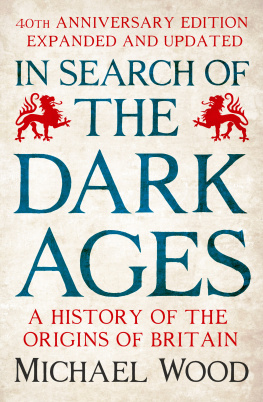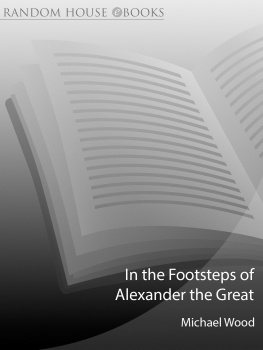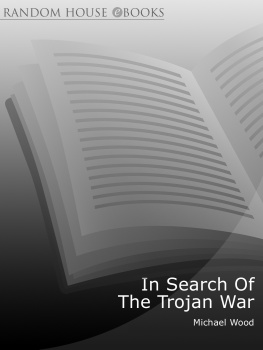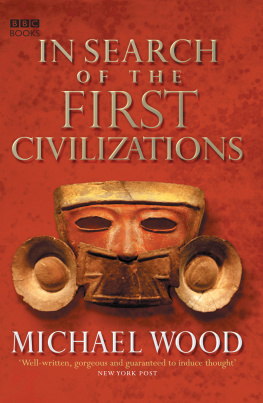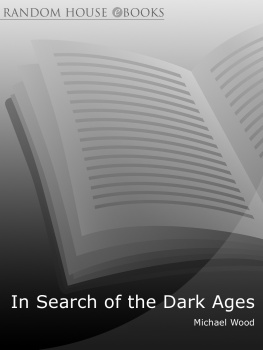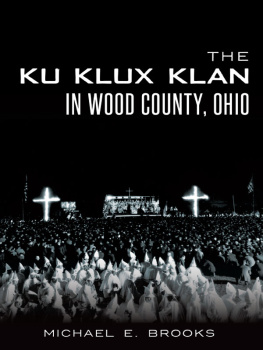Michael Wood - In search of the Trojan War
Here you can read online Michael Wood - In search of the Trojan War full text of the book (entire story) in english for free. Download pdf and epub, get meaning, cover and reviews about this ebook. City: Troy (Extinct city), Turkey--Troy (Extinct city), year: 2015, publisher: BBC Digital, genre: Art. Description of the work, (preface) as well as reviews are available. Best literature library LitArk.com created for fans of good reading and offers a wide selection of genres:
Romance novel
Science fiction
Adventure
Detective
Science
History
Home and family
Prose
Art
Politics
Computer
Non-fiction
Religion
Business
Children
Humor
Choose a favorite category and find really read worthwhile books. Enjoy immersion in the world of imagination, feel the emotions of the characters or learn something new for yourself, make an fascinating discovery.

- Book:In search of the Trojan War
- Author:
- Publisher:BBC Digital
- Genre:
- Year:2015
- City:Troy (Extinct city), Turkey--Troy (Extinct city)
- Rating:4 / 5
- Favourites:Add to favourites
- Your mark:
- 80
- 1
- 2
- 3
- 4
- 5
In search of the Trojan War: summary, description and annotation
We offer to read an annotation, description, summary or preface (depends on what the author of the book "In search of the Trojan War" wrote himself). If you haven't found the necessary information about the book — write in the comments, we will try to find it.
In search of the Trojan War — read online for free the complete book (whole text) full work
Below is the text of the book, divided by pages. System saving the place of the last page read, allows you to conveniently read the book "In search of the Trojan War" online for free, without having to search again every time where you left off. Put a bookmark, and you can go to the page where you finished reading at any time.
Font size:
Interval:
Bookmark:
CONTENTS
ONE
THE SEARCH FOR TROY
TWO
HEINRICH SCHLIEMANN
THREE
THE COMING OF THE GREEKS
FOUR
HOMER: THE SINGER OF TALES
FIVE
AGAMEMNONS EMPIRE
SIX
A FORGOTTEN EMPIRE: THE HITTITES AND THE GREEKS
SEVEN
THE PEOPLES OF THE SEA
EIGHT
THE END OF THE BRONZE AGE
About the Book
For thousands of years we have been enthralled by tales of Troy and its heroes. Achilles and Hector, Paris and the famed beauty Helen remain some of the most enduring figures in art and literature. But did these titanic characters really walk the earth? Was there ever an actual siege of Troy?
In this extensively revised edition, historian Michael Wood takes account of the latest dramatic developments in the search for Troy. His wide-ranging study of the complex archaeological, literary and historical records has been brought up to date. Detailing the rediscovery in Moscow of the so-called Jewels of Helen and the current re-excavation of the site of Troy, which continues to yield new evidence about the historical city, In Search of the Trojan War takes a fresh look at some of the most exciting discoveries in archaeology.
About the Author
For more than 20 years, historian and broadcaster Michael Wood has made compelling journeys into the past, which have brought history alive for a generation of readers and viewers. He is the author of several highly praised books on English history including In Search of the Dark Ages, The Domesday Quest, In Search of England and In Search of Shakespeare. He has over 80 documentary films to his name, among them Art of the Western World, Legacy, In the Footsteps of Alexander the Great, Conquistadors and In Search of Myths and Heroes.
Michael was born in Manchester and educated at Manchester Grammar School and Oriel College Oxford, where he did post-graduate research in Anglo-Saxon history. He is a Fellow of the Royal Historical Society.
Also by Michael Wood
The Domesday Quest: In search of the Roots of England
Conquistadors
The Story of India
In Search Of The First Civilizations
In Search Of Myths And Heroes
In The Footsteps Of Alexander The Great


It is irrelevant how many centuries may separate us from a bygone age. What matters is the importance of the past to our intellectual and spiritual existence.
ERNST CURTIUS , speech in memory of Heinrich Schliemann, Berlin, 1 March 1891.
PREFACE
A HUNDRED AND THIRTY-FIVE YEARS after Heinrich Schliemann first put spade into the fabled mound of Hisarlik in northwest Turkey, the greatest archaeological mystery is still capturing the headlines. Only recently there was the dramatic reappearance of the Jewels of Helen many had assumed that they had been destroyed during the sack of Berlin in 1945. Stored in the citys zoo in a massive concrete anti-aircraft tower, the Flakturm, the treasure (which Schliemann had associated with Helen of Troy herself) was, we now know, carried off in secret by the Soviet army; the gold ended up in Moscow and the bronzes in St Petersburg. Now at last they have been seen again, some pieces still crusted with the earth of the Trojan plain. With the prospect of exhibitions in Russia and elsewhere possibly in Greece and Turkey the tale has once again seized the public imagination.
Meanwhile, potentially even more exciting developments are taking place at Troy itself. For after a gap of over fifty years the site is being re-excavated and is already providing new evidence that what we call Troy the mound of Hisarlik is indeed the site of the legendary city sacked in the Greek epic the Iliad: the city of Priam and Hector.
The first edition of this book told the story of the three great excavations of the site of Troy by Schliemann, Wilhelm Drpfeld, and Carl Blegen. Each claimed to have answered the riddle of the Trojan War, though each found a different war in a different level of the site. None has been universally accepted as solving the mystery. It was in the summer of 1938 that the last excavators, the Cincinnati expedition under Carl Blegen, closed their trenches on Hisarlik. As they admitted, they left many questions unanswered, in part because of the earlier wrecking of the site by Schliemann, but also because of the limitations of archaeological technique at that time. Like most people, Blegen concluded that the site had now been so devastated that little new evidence could ever come out of the hill. So for a long time it seemed that Blegens report would constitute the final word on the archaeology of Troy. However, in 1988 a major new excavation was announced, a twenty-year dig on the site of the citadel and in the lower town, where many had suspected a large Bronze Age settlement might underlie the later Roman city. Well funded by the U.S. and by Daimler-Benz in Germany, Manfred Korfmann and his international team based at Tbingen University are using the whole range of modern scientific tools to establish by survey and excavation a cultural and environmental history of the region of Troy. Already, it is safe to say, a number of outstanding problems about Troy seem likely to be resolved; the results so far are summarised here in a new final chapter.
So where do things stand now on the historicity of Troy and the Trojan War? To recapitulate, the thesis of the original edition of this book was as follows. The mound of Hisarlik was the site of the historical city which the Greek poet Homer says was sacked by the Greeks during the Heroic Age. Bronze Age Hisarlik was probably the chief seat of one of the important states of western Anatolia (Aegean Turkey). These are known from diplomatic letters written on clay tablets that have been found at a number of Bronze Age sites in Turkey. Troy was perhaps a client state of the Hittite empire, which was one of the chief Near Eastern powers at that time. This state was the cause of hostilities between Greeks and Hittites in the mid-thirteenth century BC. I also argued that the conventional dating for the Trojan War established by Carl Blegen can no longer be upheld, and that the destruction of Troy might be placed earlier in the thirteenth century BC (perhaps c.12751260) when the Mycenaean Greek world was at its height, and when the Hittites were struggling to maintain a loose overlordship in western Anatolia. This, I suggested, is the true background to the historical Trojan War, which can be adduced from first-hand primary sources, the diplomatic archives of the Hittite empire, where there is evidence for Hittite relations with a powerful Great King in the Aegean world who can be identified with a mainland Greek over-king, just as legend remembered Agamemnon . In short, the essential facts of Homers story the city, the location by the Dardanelles, the Greek expedition, the war were all true.
Twenty years on, it is with a pardonable sense of relief that I can say that the speculations in the first edition of this book have not been disproved by the new discoveries; indeed, if anything they seem more, rather than less, likely to be correct. At that time there was a justifiable reluctance among many scholars to admit the idea that the epics have a real connection with historical events of the thirteenth century BC; indeed the feeling was fairly widespread that the Trojan War was simply a myth and had no relation to history whatsoever. When the first edition of this book came out, it had the honour of being vigorously attacked by the doyen of Troy sceptics, the late Sir Moses Finley. Elsewhere, though, Donald Easton devoted several pages to its thesis in the periodical
Next pageFont size:
Interval:
Bookmark:
Similar books «In search of the Trojan War»
Look at similar books to In search of the Trojan War. We have selected literature similar in name and meaning in the hope of providing readers with more options to find new, interesting, not yet read works.
Discussion, reviews of the book In search of the Trojan War and just readers' own opinions. Leave your comments, write what you think about the work, its meaning or the main characters. Specify what exactly you liked and what you didn't like, and why you think so.


